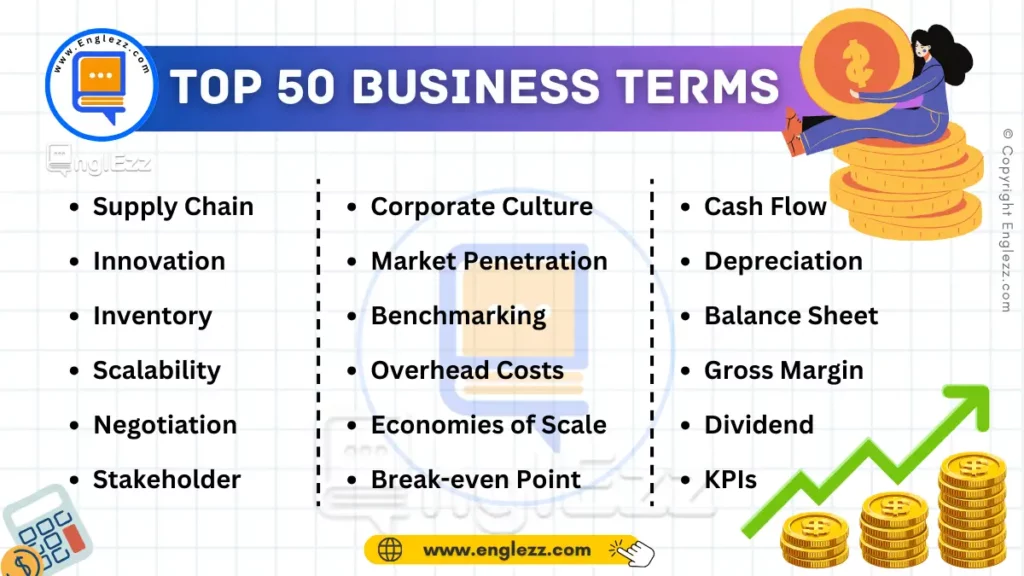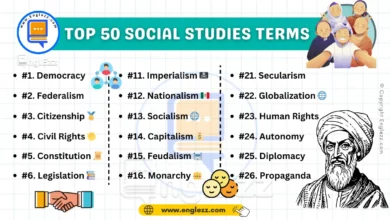In the fast-paced world of business, mastering the language of commerce is crucial for students aiming to excel in their careers. Whether you’re preparing for interviews, crafting business plans, or engaging in corporate discussions, a strong grasp of Business English terms can set you apart. This blog post aims to equip you with 50 essential Business English terms that every student must know.
Table of Contents
- Top 50 Business English Terms Explained with Examples
- #1. ROI 📈
- #2. KPI 📊
- #3. Benchmark 🏆
- #4. Synergy 🌟
- #5. Stakeholder 🧑🤝🧑
- #6. Market Segmentation 📊
- #7. Revenue Streams 💵
- #8. Value Proposition 💡
- #9. Due Diligence 🔍
- #10. Profit Margin 💰
- #11. SWOT Analysis 📉
- #12. Cash Flow 💸
- #13. Leverage 📈
- #14. Strategic Planning 📅
- #15. Market Share 📈
- #16. Competitive Advantage 🏅
- #17. Brand Equity 🌟
- #18. Outsourcing 🌍
- #19. Mergers and Acquisitions 🤝
- #20. Value Chain 🔗
- #21. Business Model 🏢
- #22. Intellectual Property (IP) 💡
- #23. Corporate Governance 🏛️
- #24. Business Analytics 📊
- #25. Risk Management ⚠️
- #26. Negotiation 🤝
- #27. Market Penetration 📈
- #28. Asset Management 🏦
- #29. Supply Chain Management 📦
- #30. Human Resources (HR) 👥
- #31. E-Commerce 🛒
- #32. Customer Relationship Management (CRM) 💬
- #33. Operational Efficiency ⚙️
- #34. Innovation 💡
- #35. Business Development 🚀
- #36. Corporate Social Responsibility (CSR) 🌍
- #37. Financial Statements 📑
- #38. Revenue Model 💵
- #39. Scalability 📈
- #40. Customer Acquisition Cost (CAC) 💸
- #41. Value-added Tax (VAT) 🧾
- #42. Business Process Optimization ⚙️
- #43. Enterprise Resource Planning (ERP) 🖥️
- #44. Portfolio Management 📈
- #45. Business Continuity Planning 📋
- #46. Corporate Strategy 📋
- #47. Supply Chain Optimization 🚚
- #48. Financial Forecasting 📈
- #49. Return on Assets (ROA) 📊
- #50. Business Valuation 💼
- Business English Terms Table
- Conclusion
Top 50 Business English Terms Explained with Examples
Each term is carefully selected to enhance your business vocabulary, offering clear definitions, phonetic transcriptions, and practical examples to illustrate their usage. By familiarizing yourself with these terms, you can communicate more effectively, understand industry jargon, and make a lasting impression in professional settings. Dive into this comprehensive guide to boost your business language skills and gain the confidence you need to succeed in the corporate world.
#1. ROI 📈
Definition: Return on Investment; a measure of the profitability of an investment.
Phonetic Transcription: /ˈɑːr.oʊ.aɪ/
Examples:
- “The company’s ROI on the new marketing campaign was 150%, indicating a highly successful initiative.”
- “Investors are keenly interested in the ROI of the new product line.”
#2. KPI 📊
Definition: Key Performance Indicator; a measurable value that demonstrates how effectively a company is achieving key business objectives.
Phonetic Transcription: /ˈkeɪ.piː.aɪ/
Examples:
- “Customer satisfaction scores are a crucial KPI for the customer service department.”
- “The sales team’s KPI for this quarter includes increasing revenue by 20%.”
#3. Benchmark 🏆
Definition: A standard or point of reference against which things may be compared or assessed.
Phonetic Transcription: /ˈbɛnʧˌmɑrk/
Examples:
- “The company’s performance is evaluated against industry benchmarks to gauge its success.”
- “We use benchmarking to set targets for improving our operational efficiency.”
#4. Synergy 🌟
Definition: The interaction of multiple elements to produce a combined effect greater than the sum of their separate effects.
Phonetic Transcription: /ˈsɪn.ɚ.dʒi/
Examples:
- “The merger created significant synergy, leading to increased productivity and cost savings.”
- “Team synergy improved after the team-building exercises.”
#5. Stakeholder 🧑🤝🧑
Definition: An individual or group with an interest in the success or failure of a project or business.
Phonetic Transcription: /ˈsteɪkˌhoʊldər/
Examples:
- “Stakeholders include employees, customers, and investors.”
- “Regular updates are provided to stakeholders to keep them informed about project progress.”

#6. Market Segmentation 📊
Definition: The process of dividing a broad consumer or business market into sub-groups of consumers based on some shared characteristics.
Phonetic Transcription: /ˈmɑːrkɪt ˌsɛɡmənˈteɪʃən/
Examples:
- “Market segmentation helps tailor marketing strategies to specific consumer needs.”
- “Our market segmentation revealed three distinct target audiences for the new product.”
#7. Revenue Streams 💵
Definition: The various sources from which a business earns money.
Phonetic Transcription: /ˈrɛvəˌnuː striːmz/
Examples:
- “Diversifying revenue streams can help stabilize the company’s financial performance.”
- “The company’s revenue streams include subscription fees and advertising revenue.”
#8. Value Proposition 💡
Definition: A statement that explains how a product or service solves a problem or improves a situation for a customer.
Phonetic Transcription: /ˈvæljuː ˌprɒpəˈzɪʃən/
Examples:
- “Our value proposition emphasizes the unique benefits of our service compared to competitors.”
- “A clear value proposition helps attract and retain customers.”
#9. Due Diligence 🔍
Definition: The investigation or exercise of care that a reasonable person or organization is expected to undertake before entering into an agreement or transaction.
Phonetic Transcription: /djuː ˈdɪlɪdʒəns/
Examples:
- “Due diligence is essential before acquiring another company.”
- “The investors conducted thorough due diligence before finalizing the deal.”
#10. Profit Margin 💰
Definition: The difference between the cost of producing a product and its selling price, expressed as a percentage of the selling price.
Phonetic Transcription: /ˈprɒfɪt ˈmɑːrdʒɪn/
Examples:
- “The company’s profit margin increased after reducing production costs.”
- “A higher profit margin indicates a more profitable business.”
#11. SWOT Analysis 📉
Definition: A strategic planning technique used to identify the Strengths, Weaknesses, Opportunities, and Threats related to a business or project.
Phonetic Transcription: /swɑːt əˈnælɪsɪs/
Examples:
- “A SWOT analysis helped the company identify key areas for improvement.”
- “The marketing team used SWOT analysis to strategize for the upcoming campaign.”
#12. Cash Flow 💸
Definition: The total amount of money being transferred into and out of a business, especially as affecting liquidity.
Phonetic Transcription: /kæʃ floʊ/
Examples:
- Managing cash flow is crucial for maintaining the company’s financial health.
- “Positive cash flow allows the business to invest in new opportunities.”
#13. Leverage 📈
Definition: The use of various financial instruments or borrowed capital—in other words, debt—to increase the potential return of an investment.
Phonetic Transcription: /ˈlɛvərɪdʒ/
Examples:
- “The company used leverage to expand its operations rapidly.”
- “Leverage can amplify both gains and losses.”
#14. Strategic Planning 📅
Definition: The process of defining a business’s direction and making decisions on allocating resources to pursue this direction.
Phonetic Transcription: /strəˈtiːdʒɪk ˈplænɪŋ/
Examples:
- Effective strategic planning involves setting clear goals and objectives.”
- “The company’s strategic planning included market expansion and product innovation.”
Definition: The portion of a market controlled by a particular company or product.
Phonetic Transcription: /ˈmɑːrkɪt ʃɛər/
Examples:
- “Increasing market share is a key goal for many businesses.”
- “The company’s market share grew significantly after the product launch.”
#16. Competitive Advantage 🏅
Definition: A condition or circumstance that puts a company in a favorable or superior business position.
Phonetic Transcription: /kəmˈpɛtɪtɪv ædˈvɑːntɪdʒ/
Examples:
- “Technological innovation provided the company with a competitive advantage.
- “A strong brand identity can be a significant competitive advantage.”
#17. Brand Equity 🌟
Definition: The value a brand adds to a product or service beyond the functional benefits it provides.
Phonetic Transcription: /brænd ˈekwɪti/
Examples:
- “Strong brand equity can lead to higher sales and customer loyalty.”
- “The company’s brand equity improved after its successful marketing campaign.”
#18. Outsourcing 🌍
Definition: The practice of obtaining goods or services from an outside or foreign supplier, especially in place of an internal source.
Phonetic Transcription: /ˈaʊtsaʊrsɪŋ/
Examples:
- “Outsourcing IT services can reduce operational costs.”
- “The company decided to outsource customer support to improve service quality.”
#19. Mergers and Acquisitions 🤝
Definition: Mergers involve the combining of two companies into one, while acquisitions involve one company buying another.
Phonetic Transcription: /ˈmɜːrdʒərz ənd ˌækwɪˈzɪʃənz/
Examples:
- “Mergers and acquisitions can create significant growth opportunities for businesses.”
- “The recent acquisition expanded the company’s market presence.”
#20. Value Chain 🔗
Definition: The series of activities that a company performs to deliver a valuable product or service to the market.
Phonetic Transcription: /ˈvæljuː ʧeɪn/
Examples:
- “Analyzing the value chain helps identify areas for cost reduction.”
- “Improving the value chain can enhance overall product quality.”
#21. Business Model 🏢
Definition: A plan or strategy for how a company will operate, earn revenue, and deliver value to customers.
Phonetic Transcription: /ˈbɪznəs ˈmɒdəl/
Examples:
- “The company’s business model focuses on subscription-based revenue.”
- “Adapting the business model to market changes is crucial for success.”
#22. Intellectual Property (IP) 💡
Definition: Creations of the mind, such as inventions, literary and artistic works, designs, symbols, names, and images used in commerce.
Phonetic Transcription: /ˌɪntəˈlɛktjʊəl ˈprɒpəti/
Examples:
- “Protecting intellectual property is essential for maintaining a competitive edge.”
- “The company secured patents to safeguard its intellectual property.”
#23. Corporate Governance 🏛️
Definition: The system of rules, practices, and processes by which a company is directed and controlled.
Phonetic Transcription: /ˈkɔːr.pə.rət ˈɡʌvər.nəns/
Examples:
- “Strong corporate governance practices enhance company transparency.”
- “Corporate governance includes the roles of the board of directors and executive management.”
#24. Business Analytics 📊
Definition: The skills, technologies, practices for continuous iterative exploration, and investigation of past business performance to gain insight and drive business planning.
Phonetic Transcription: /ˈbɪznəs ænəˈlɪtɪks/
Examples:
- “Business analytics tools help companies make data-driven decisions.”
- “Effective use of business analytics can improve operational efficiency.”
#25. Risk Management ⚠️
Definition: The identification, assessment, and prioritization of risks followed by coordinated efforts to minimize, monitor, and control the probability or impact of unfortunate events.
Phonetic Transcription: /rɪsk ˈmænɪdʒmənt/
Examples:
- “Risk management strategies are essential for protecting business assets.”
- “The company’s risk management plan includes insurance and contingency measures.”
#26. Negotiation 🤝
Definition: A discussion aimed at reaching an agreement between parties with differing interests.
Phonetic Transcription: /nɪˌɡoʊʃiˈeɪʃən/
Examples:
- “Effective negotiation skills are crucial for closing deals and forming partnerships.”
- “The team engaged in negotiations to secure better contract terms.”
#27. Market Penetration 📈
Definition: The strategy of increasing a company’s share of the market for its products or services.
Phonetic Transcription: /ˈmɑːrkɪt ˌpɛnɪˈtreɪʃən/
Examples:
- “Market penetration strategies include pricing adjustments and increased marketing efforts.”
- “The company achieved high market penetration through aggressive advertising.”
#28. Asset Management 🏦
Definition: The systematic process of developing, operating, maintaining, and selling assets in a cost-effective manner.
Phonetic Transcription: /ˈæst ˈmænɪdʒmənt/
Examples:
- “Effective asset management maximizes the value of company assets.”
- “The firm employs asset management strategies to optimize returns.”
#29. Supply Chain Management 📦
Definition: The management of the flow of goods and services, including all processes that transform raw materials into final products.
Phonetic Transcription: /səˈplaɪ ʧeɪn ˈmænɪdʒmənt/
Examples:
- “Supply chain management ensures that products are delivered efficiently.”
- “Improvements in supply chain management can reduce costs and increase customer satisfaction.”
#30. Human Resources (HR) 👥
Definition: The department of a company that deals with hiring, administration, and training of employees.
Phonetic Transcription: /ˈhjuːmən rɪˈzɔːrsɪz/
Examples:
- “Human resources handle employee recruitment and benefits administration.”
- “HR plays a key role in employee development and workplace culture.”
#31. E-Commerce 🛒
Definition: Commercial transactions conducted electronically on the internet.
Phonetic Transcription: /ˈiːˌkɒmɜːrs/
Examples:
- “E-commerce platforms enable businesses to reach a global audience.”
- “The company saw a significant increase in sales through its e-commerce website.”
#32. Customer Relationship Management (CRM) 💬
Definition: A strategy for managing a company’s interactions with current and potential customers, often using data analysis to improve relationships.
Phonetic Transcription: /ˈkʌstəmər rɪˈleɪʃənˌʃɪp ˈmænɪdʒmənt/
Examples:
- “CRM systems help businesses track customer interactions and enhance service.”
- “Effective CRM can lead to improved customer satisfaction and loyalty.”
#33. Operational Efficiency ⚙️
Definition: The ability of a company to deliver products or services in the most cost-effective manner without sacrificing quality.
Phonetic Transcription: /ˌɒpəˈreɪʃənl ɪˈfɪʃənsi/
Examples:
- “Operational efficiency can be improved through process optimization.”
- “The company’s focus on operational efficiency resulted in reduced production costs.”
#34. Innovation 💡
Definition: The introduction of new ideas, products, or methods to improve or create value.
Phonetic Transcription: /ˌɪnəˈveɪʃən/
Examples:
- “Innovation drives competitive advantage and growth in the industry.”
- The company invests heavily in research and development to foster innovation.
#35. Business Development 🚀
Definition: The activities and processes undertaken to create growth opportunities for a business.
Phonetic Transcription: /ˈbɪznəs dɪˈvɛləpmənt/
Examples:
- “Business development strategies include exploring new markets and forming partnerships.”
- “The company’s business development team focuses on expanding its customer base.”
#36. Corporate Social Responsibility (CSR) 🌍
Definition: A company’s commitment to operating in an ethical and sustainable manner that benefits society.
Phonetic Transcription: /ˈkɔːr.pə.rət ˈsoʊʃəl rɪˌspɒnsəˈbɪləti/
Examples:
- “Corporate social responsibility initiatives include environmental sustainability and community support.”
- “CSR practices can enhance a company’s reputation and customer loyalty.”
#37. Financial Statements 📑
Definition: Formal records of the financial activities and position of a business, person, or other entity.
Phonetic Transcription: /faɪˈnænʃəl ˈsteɪtmənts/
Examples:
- “Financial statements provide insights into a company’s profitability and financial health.”
- “Investors review financial statements to assess the company’s performance.”
#38. Revenue Model 💵
Definition: The method by which a company generates income from its operations.
Phonetic Transcription: /ˈrɛvəˌnuː ˈmɒdəl/
Examples:
- “The company’s revenue model includes subscription fees and advertising.”
- “Understanding the revenue model helps in forecasting financial performance.”
#39. Scalability 📈
Definition: The capability of a company or system to grow and manage increased demand without compromising performance.
Phonetic Transcription: /ˌskeɪləˈbɪləti/
Examples:
- “Scalability is an important factor in selecting technology solutions for the business.”
- “The company’s business model is designed to be highly scalable.”
#40. Customer Acquisition Cost (CAC) 💸
Definition: The cost associated with acquiring a new customer.
Phonetic Transcription: /ˈkʌstəmər ˌækwɪˈzɪʃən kɒst/
Examples:
- “Reducing customer acquisition costs can improve overall profitability.”
- “The marketing campaign was analyzed to determine its impact on CAC.”
#41. Value-added Tax (VAT) 🧾
Definition: A consumption tax placed on a product whenever value is added at each stage of the supply chain.
Phonetic Transcription: /ˈvæljuː ˈædəd tæks/
Examples:
- “The company included VAT in the final price of its products.”
- “Understanding VAT regulations is important for international business transactions.”
#42. Business Process Optimization ⚙️
Definition: The practice of improving business processes to increase efficiency, effectiveness, and adaptability.
Phonetic Transcription: /ˈbɪznəs ˈprəʊsɛs ˌɒptɪmaɪˈzeɪʃən/
Examples:
- “Business process optimization can lead to significant cost savings.”
- “The team implemented new technologies to streamline operations.”
#43. Enterprise Resource Planning (ERP) 🖥️
Definition: Integrated management of core business processes, often in real-time, mediated by software and technology.
Phonetic Transcription: /ˈɛntəˌpraɪz rɪˈzɔːrs ˈplænɪŋ/
Examples:
- “ERP systems help in coordinating business functions and improving data accuracy.”
- “The company adopted an ERP system to integrate its supply chain and accounting processes.”
#44. Portfolio Management 📈
Definition: The process of managing a group of investments or projects to achieve specific financial goals.
Phonetic Transcription: /pɔːrtˈfoʊlioʊ ˈmænɪdʒmənt/
Examples:
- Effective portfolio management involves balancing risk and return.
- “The investment firm provides portfolio management services to its clients.”
#45. Business Continuity Planning 📋
Definition: The process of creating systems of prevention and recovery to deal with potential threats to a company.
Phonetic Transcription: /ˈbɪznəs kənˈtɪn.juː.ɪ.ti ˈplænɪŋ/
Examples:
- “Business continuity planning ensures that operations can continue during disruptions.”
- “The company developed a continuity plan to address potential natural disasters.”
#46. Corporate Strategy 📋
Definition: The overall plan of a corporation that guides its direction and decision-making to achieve long-term objectives.
Phonetic Transcription: /ˈkɔːr.pə.rət ˈstrætədʒi/
Examples:
- “Corporate strategy involves setting long-term goals and allocating resources.”
- “The company’s corporate strategy focuses on market expansion and innovation.”
#47. Supply Chain Optimization 🚚
Definition: The process of improving the efficiency and effectiveness of the supply chain to reduce costs and increase value.
Phonetic Transcription: /səˈplaɪ ʧeɪn ˌɒptɪmaɪˈzeɪʃən/
Examples:
- “Supply chain optimization can lead to faster delivery times and reduced expenses.”
- “The company implemented new logistics solutions to optimize its supply chain.”
#48. Financial Forecasting 📈
Definition: The process of estimating future financial outcomes based on historical data and market analysis.
Phonetic Transcription: /faɪˈnænʃəl ˈfɔːrkæstɪŋ/
Examples:
- “Financial forecasting helps businesses plan for future growth and budget accordingly.”
- “The company used financial forecasting to prepare for potential market fluctuations.”
#49. Return on Assets (ROA) 📊
Definition: A financial ratio that measures the profitability of a company relative to its total assets.
Phonetic Transcription: /rɪˈtɜrn ɒn ˈæsts/
Examples:
- “ROA is an important indicator of how effectively a company is using its assets.”
- “The company’s ROA improved after optimizing its asset management.”
#50. Business Valuation 💼
Definition: The process of determining the current worth of a business or company.
Phonetic Transcription: /ˈbɪznəs ˌvæl.juˈeɪ.ʃən/
Examples:
- “Business valuation is essential for mergers, acquisitions, and investment opportunities.”
- “The valuation process included analyzing financial statements and market conditions.”
Business English Terms Table
| #1. ROI 📈 | #11. Brand Equity 🏆 | #21. Intellectual Property 💡 |
| #2. KPI 📊 | #12. Market Segmentation 📊 | #22. Corporate Governance 🏛️ |
| #3. EBITDA 💹 | #13. SWOT Analysis 🧠 | #23. Business Analytics 📊 |
| #4. Venture Capital 💰 | #14. Customer Retention 🔄 | #24. Risk Management ⚠️ |
| #5. Market Share 📉 | #15. Profit Margin 💵 | #25. Negotiation 🤝 |
| #6. Revenue Streams 💵 | #16. Value Proposition 🎯 | #26. Market Penetration 📈 |
| #7. Business Model 💼 | #17. ROI Analysis 📊 | #27. Asset Management 🏦 |
| #8. Capital Expenditure 💸 | #18. Strategic Planning 📋 | #28. Supply Chain Management 📦 |
| #9. Break-even Point 📊 | #19. Business Development 🚀 | #29. Human Resources (HR) 👥 |
| #10. Cash Flow 💵 | #20. E-Commerce 🛒 | #30. CRM 💬 |
Conclusion
Understanding Business English terms is more than just knowing their definitions; it’s about applying them effectively in real-world scenarios. This comprehensive list of 50 business terms provides a solid foundation for any student eager to make a mark in the corporate world.
Mastering these terms will not only enhance your vocabulary but also equip you with the language skills needed to navigate complex business environments.
From ROI and KPIs to market segmentation and supply chain management, each term plays a crucial role in business operations and strategy.
By familiarizing yourself with these concepts, you’ll be better prepared to engage in meaningful discussions, make informed decisions, and contribute to your organization’s success.
Stay ahead of the curve by continuously expanding your business language skills and applying them in practical situations.








